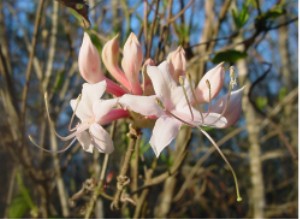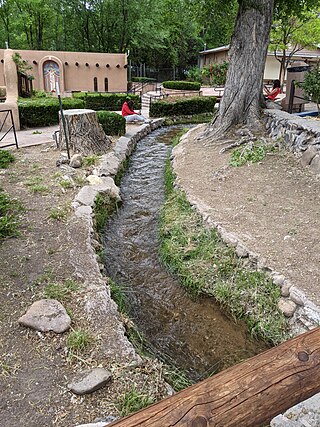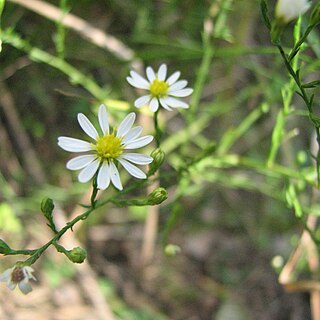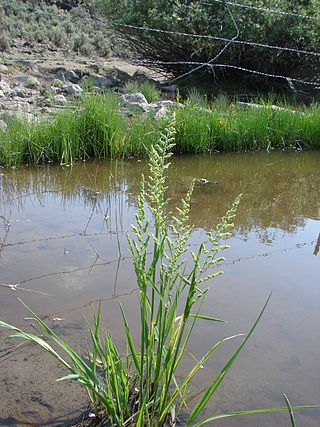
Angelica is a genus of about 90 species of tall biennial and perennial herbs in the family Apiaceae, native to temperate and subarctic regions of the Northern Hemisphere, reaching as far north as Iceland, Sápmi, and Greenland. They grow to 1–3 m tall, with large bipinnate leaves and large compound umbels of white or greenish-white flowers. Found mainly in China, its main use was for medicine. It shows variations in fruit anatomy, leaf morphology, and subterranean structures. The genes are extremely polymorphic.

Rhododendron atlanticum, the dwarf azalea or coastal azalea, is a species of Rhododendron native to coastal areas of the eastern United States, from New Jersey south to Georgia.

An acequia or séquia is a community-operated watercourse used in Spain and former Spanish colonies in the Americas for irrigation. Acequias are found in parts of Spain, the Andes, northern Mexico, and the modern-day American Southwest.

The old Chain of Rocks Bridge spans the Mississippi River on the north edge of St. Louis, Missouri, United States. The eastern end of the bridge is on Chouteau Island, while the western end is on the Missouri shoreline. Its most notable feature is a 22-degree bend occurring at the middle of the crossing, which was found to be necessary during construction due to both the presence of a water intake and the inability of parts of the bedrock of the river to carry the weight of the bridge.

Merritt Lyndon Fernald was an American botanist. He was a respected scholar of the taxonomy and phytogeography of the vascular plant flora of temperate eastern North America. During his career, Fernald published more than 850 scientific papers and wrote and edited the seventh and eighth editions of Gray's Manual of Botany. Fernald coauthored the book Edible Wild Plants of Eastern North America in 1919–1920 with Alfred Kinsey, which was published in 1943.

The yellowfin grouper is a species of marine ray-finned fish, a grouper from the subfamily Epinephelinae which is part of the family Serranidae, which also includes the anthias and sea basses. It is found in the warmer waters of the western Atlantic Ocean.

The Fernald Feed Materials Production Center is a Superfund site located within Crosby Township in Hamilton County, Ohio, as well as Ross Township in Butler County, Ohio, in the United States. It was a uranium processing facility located near the rural town of New Baltimore, about 20 miles (32 km) northwest of Cincinnati, which fabricated uranium fuel cores for the U.S. nuclear weapons production complex from 1951 to 1989. During that time, the plant produced 170,000 metric tons uranium (MTU) of metal products and 35,000 MTU of intermediate compounds, such as uranium trioxide and uranium tetrafluoride.

Iris fernaldii, commonly known as Fernald's iris, is a species of iris endemic to western Northern California. It is native to the Inner and Outer North California Coast Ranges, such as the Santa Cruz Mountains, and surrounding the San Francisco Bay Area. It is found between 164–6,562 feet (50–2,000 m) in elevation. It grows in full sun near the coast, and afternoon shade inland.

Symphyotrichum depauperatum, commonly known as serpentine aster or starved aster, is a rare species in the family Asteraceae adapted to serpentine barrens, an ecosystem with a high concentration of toxic metals in the soil. It has been found in Pennsylvania, Maryland, and on some diabase glades in North Carolina. It grows to 50 centimeters and has white ray florets surrounding a center of yellow disk florets.

Beckmannia syzigachne, the American sloughgrass, or slough grass, is an annual or short-lived perennial bunchgrass in the grass family, Poaceae, found in shallow marshes or sloughs.

Cirsium pumilum var. hillii is a type of thistle endemic to North America. The common name for this plant is Hill's thistle.

Eriophorum viridicarinatum is a species of sedge known by the common names thinleaf cottonsedge, green-keeled cottongrass, and bog cottongrass. It is native to Canada and the United States.

Eulophia ecristata, synonym Orthochilus ecristatus, or giant orchid, is a terrestrial species of orchid native to Cuba and to the southeastern United States. In 2014, it was proposed that the species should be transferred to the genus Orthochilus, but as of December 2023 this was not accepted by Plants of the World Online. This is one of several species known as a "giant orchid".

Antennaria parlinii, known as Parlin's pussytoes, is a herbaceous flowering plant in the family Asteraceae. Like other species in the genus, the plant is dioecious. It is widespread across eastern and central Canada and eastern and central United States, from Manitoba to Nova Scotia south as far as Texas and Georgia.

Arnoglossum sulcatum, the Georgia Indian plantain, is a North American species of plants in the sunflower family. It is native to the southeastern United States in the states of Mississippi, Alabama, Georgia, and Florida.

Bidens eatonii is a North American species of flowering plant in the family Asteraceae. It is native to eastern Canada and the northeastern United States.

Bidens hyperborea is a variable species of flowering plant in the family Asteraceae, known from estuarine regions in northeastern North America. It is similar to Bidens cernua, Bidens laevis, and Bidens eatonii. B. hyperborea is listed as an endangered species in the state of Massachusetts, where it is threatened by habitat degradation, and is listed by NatureServe as critically imperiled (S1) in the province of Ontario and possibly extirpated from New Hampshire.

Adyar Creek is a backwater estuary located in Adyar, Chennai at the mouth of the Adyar River along the Coromandel Coast of the Bay of Bengal. The creek begins near the Chetinnad Palace, extending northward into the mainland and taking a complete U-turn near the Foreshore Estate before ending near Mandavelipakkam. The creek surrounds the Quibble Island.
Parartocarpus venenosa is a tree species in the family Moraceae.


















